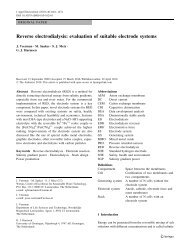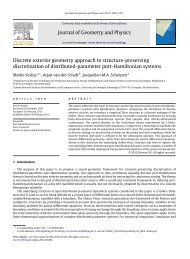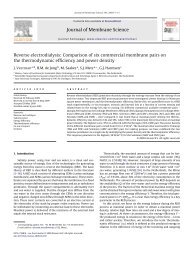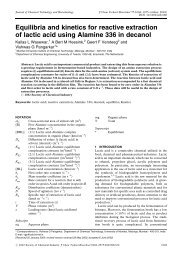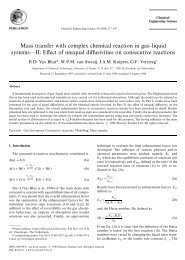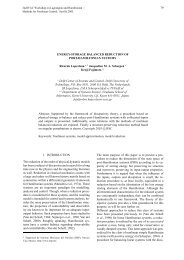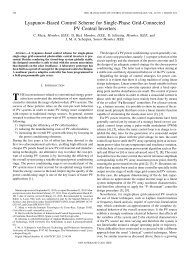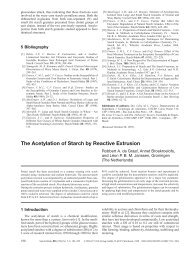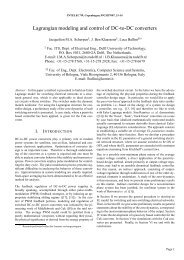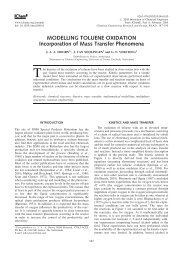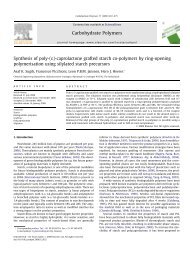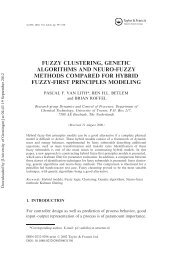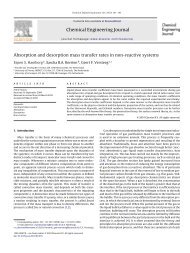Mass transfer with complex chemical reaction in gas—liquid ... - ITM
Mass transfer with complex chemical reaction in gas—liquid ... - ITM
Mass transfer with complex chemical reaction in gas—liquid ... - ITM
You also want an ePaper? Increase the reach of your titles
YUMPU automatically turns print PDFs into web optimized ePapers that Google loves.
R.D. Vas Bhat et al./Chemical Eng<strong>in</strong>eer<strong>in</strong>g Science 54 (1999) 121—136 127Fig. 2. Effect of K on enhancement factor. Consecutive (irr)—(rev) <strong>reaction</strong>.<strong>with</strong> the presently obta<strong>in</strong>ed numerical results forlow Hatta numbers (Ha(3). A maximum deviation of5.8% was seen for the lowest Hatta number (Ha"1)while for higher Hatta numbers the agreement was muchbetter.4.2. First <strong>reaction</strong> irreversible—second <strong>reaction</strong> reversibleThe results from the simulation for the above case aregiven <strong>in</strong> Fig. 2 for K "10. As may be observed, the<strong>in</strong>itial part of the curve is similar to a second orderirreversible <strong>reaction</strong> and can be described <strong>with</strong> availabletechniques (e.g. DeCoursey, 1974) till the curve reachesthe <strong>in</strong>termediate asymptotic enhancement value. For thecase of equal diffusivities, the value of E correspondsto the quantity (1# B /A ). As Ha <strong>in</strong>creases further, thefirst <strong>reaction</strong> becomes <strong>in</strong>stantaneous <strong>with</strong> respect to mass<strong>transfer</strong> so that, now, further enhancement is essentiallyprovided by the second <strong>reaction</strong>.4.2.1. Effect of K From Fig. 2 it is clear that the value of K <strong>in</strong>fluencesthe f<strong>in</strong>al <strong>in</strong>f<strong>in</strong>ite enhancement factor. For very lowK (typically(10) practically no further enhancementis provided by the second <strong>reaction</strong>. This is obvious as atsuch low K , the net production of E and F is very low;the effect of the forward <strong>reaction</strong> <strong>reaction</strong> (1c) is overruledby the comparatively fast backward <strong>reaction</strong> of<strong>reaction</strong> (1c) result<strong>in</strong>g <strong>in</strong> negligible additional absorptionof A. With an <strong>in</strong>crease <strong>in</strong> K , the rate of the forward<strong>reaction</strong> (1c) <strong>in</strong>creases, result<strong>in</strong>g <strong>in</strong> greater absorption ofA and a higher enhancement factor. However, the valueof E cannot exceed the value for the case where both<strong>reaction</strong>s are irreversible (8). This corresponds to a valueof E "9 for the <strong>in</strong>itial concentrations used <strong>in</strong> the simulationspresented <strong>in</strong> Fig. 2.4.2.2. F<strong>in</strong>al <strong>in</strong>f<strong>in</strong>ite enhancement factor, E It is observed that the f<strong>in</strong>al <strong>in</strong>f<strong>in</strong>ite enhancementfactor, E , can be described by the follow<strong>in</strong>gequation:E "E #E !1 (12)where E and E are the contributions of <strong>reaction</strong>s(1b) and (1c) to the f<strong>in</strong>al <strong>in</strong>f<strong>in</strong>ite enhancement factor. Forirreversible <strong>chemical</strong> <strong>reaction</strong> and equal reactant diffusivities,E is given byE "1# B A . (13)The value of E may be obta<strong>in</strong>ed from standard techniquesfor <strong>in</strong>f<strong>in</strong>ite enhancement factors for s<strong>in</strong>gle reversible<strong>reaction</strong>s (e.g. DeCoursey and Thr<strong>in</strong>g, 1989; Secorand Beutler, 1967). However, <strong>in</strong> order to use these techniques,the value of the <strong>in</strong>itial concentration of the <strong>in</strong>termediateC is required. S<strong>in</strong>ce at these Hatta numbers, Eq.(1b) is <strong>in</strong>stantaneous <strong>with</strong> respect to mass <strong>transfer</strong>, it canbe assumed that all B present <strong>in</strong>itially is completelyconverted to C. In other words, one may assume thatthe <strong>in</strong>itial concentration of C is the same as the <strong>in</strong>itialconcentration of B. Table 3 compares the approximatef<strong>in</strong>al <strong>in</strong>f<strong>in</strong>ite enhancement factor from Eq. (12) tothose obta<strong>in</strong>ed numerically. The DeCoursey and Thr<strong>in</strong>g(1989) technique has been used for evaluat<strong>in</strong>g E .As can be observed, the differences <strong>in</strong> the values arenegligible.4.3. First <strong>reaction</strong> reversible—second <strong>reaction</strong> irreversibleThe results for the above case are presented <strong>in</strong> Fig.3 for K "10. The results may be expla<strong>in</strong>ed on thebasis of the follow<strong>in</strong>g parameters:



